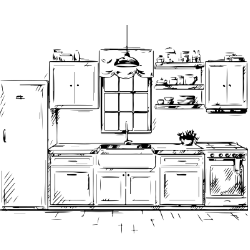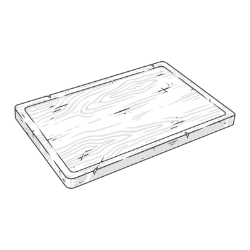
How To Install A Farmhouse Sink - A Simple Guide For DIY
A Simple Guide To Installing Your Farmhouse Sink
Step 1: Choose the right sink and order it early
Step 2: Check the Manufacturer's Installation Instructions.
Step 3: Cut Your Countertops
Step 4: Cut Your Cabinet Face
Step 5: Build Your Supports
Step 6: Finish Your Cabinet Fronts and Install your Counters and Plumbing Fixtures.
For more details on these specific steps continue reading... We hope you find our diagrams helpful! Be sure to read to the end we give a FREE PDF download so you can print it off and take it with you.
One of the hardest things about a kitchen renovation is finding ways to make your design stand out from being just another kitchen. Yet finding those extra elements can be exhausting, and you never know exactly how it will all come together in the end.
Farmhouse sinks have become extremely popular because they instantly transform your design and give it that sought-after wow factor, which can be difficult to attain. But, they are installed a little differently than traditional sinks and you might be wondering what it takes. Luckily, we've put together this guide to give you a complete, step-by-step understanding of what you're in for. Farmhouse sink installation can be done!
We'll let you in on a little secret - it's much simpler than you think!
Step 1. Choose the Right Sink - and Order it Early!
Why order early?
Fireclay farmhouse sinks are sought-after, large and heavy. This translates into frequent backorders and, depending on the sink, sometimes freight shipping - which can take up to a week longer than a normal FedEx delivery. For more specific shipping times search the sink you're looking for on our website. On the product page, you'll see the " get it by " date.
When a sink is back-ordered, beware of websites that say “usually ships in 2 weeks” or “usually ships in 3-4 weeks”. These are often standard lines that aren’t checked against the actual delivery date of the next shipment. At Annie & Oak always state the estimated arrival date (if available) of the new shipment so you will have a much clearer picture of when you’ll be getting your sink. This way you can plan your sink arrival around your kitchen renovation and not the other way around!
Farmhouse Sink Sizes & Dimensions
When installing your farm sink as an undermount option choose a cabinet that is 3 inches wider than your sink. This allows for 1.5 inches on either side. The most popular sizes of front apron/farm sinks are:
Popular sink sizes:
If you’re going for a double basin sink and you have space, don’t be afraid to opt for the 36” or 39” size – they will give you a little extra room to work with and they look amazing! If you have a small kitchen, we recommend a smaller sized (eg. 24-26”) sink. It will give the whole space a balanced look – and you’ll come out of this looking like a pro.
Diagram 1. The main dimension of your farmhouse sink is the length (side to side).

Cabinet Sizes
If you haven’t picked out your base cabinet, and your cabinet maker or designer (or you, if you’re going the DIY route) hasn’t already planned/designed for it, you can choose any size you like! You’ll just need to get a base cabinet wide enough to fit it.
If you do have a cabinet maker, however, you should discuss it with them first - even if they haven't made or designed your cabinets yet. They will know exactly what size will work best, which will make everything much easier for both of you.
Often times we ship Farmhouse sinks directly to the cabinet makers for convenience. If you would rather do this be sure to add their address as the shipping address.
Do You Already Have Your Base Cabinet?
If so, you will need to figure out what it can accommodate. Most manufacturers will give a ‘minimum base cabinet size’ recommendation with each sink, and it is generally 3” larger than the sink length. Your main concern will be what dimensions your cabinet can fit, and how it can be customized to accommodate the sink you pick.
The maximum length (side to side size) of your sink will be about ¼” less than the inner width of your cabinet. And the maximum overall height of your sink will be the distance between the top of your cabinet base and the top of your cabinet doors. We will be cutting out the cabinet face to fit your sink in step 4.
If your cabinet doors are going to be custom made, you won’t have to worry about the sink height. You can have them custom fit.
Diagram 2. Determining your maximum sink width and height based on your individual cabinet size

What About the Width (Front to Back)?
Most sinks are between 18-20” wide. Unless you are particular about this measurement, don’t fret. They are designed to ensure enough space for your faucet. It’s just personal preference and the difference between brands. It won’t affect your installation.
What Type of Farmhouse Sink Should You Get?
Now that you know what size you need, there are are some other options to consider, such as the number of basins (single or double), what material you want (read descriptions below), the color and whether you want a smooth apron or a design such as fluted.
Fireclay Farmhouse Sink
If you know you want a farmhouse sink, but aren’t sure about the material, we generally recommend a fireclay farm sink. It is typically showcased in designer kitchens and magazines – and is probably what you have in mind. The look blends in easily with any décor, from modern to traditional, and hasn’t gone out of style for centuries!
Fireclay is extremely durable, much more so than ceramic due to the manufacturing process. It is coated with a thick glaze that binds to the clay during the firing process – which occurs at temperatures more than 1800°F, and for a much longer time than ceramic. The results are an easy-to-wipe-clean glossy surface and a hard material that is very resistant to chips, cracks, stains, and scratches. In fact, most marks on fireclay are from metals rubbing off on the sink, and they’re easily removed with a little elbow grease. We recommend using a warm soapy cloth for easy cleanup.
Copper Farmhouse Sink
A copper sink can be a show-stopper centerpiece in the kitchen. It has a beautifully rustic look that will constantly evolve with age. This is due to its living finish, called the patina. The patina is naturally antimicrobial and requires very little maintenance. Occasionally it will lighten in spots when exposed to acid, but don’t worry! It will naturally darken again over time.
Copper is also eco-friendly being completely recyclable – and new sinks are often made from recycled materials. Copper is also naturally antimicrobial, which kills the majority of harmful bacteria keeping you and your family safe from unwanted germs.
Stainless Steel Farmhouse Sink
Stainless steel farmhouse sinks fit in nicely with modern kitchens and stainless appliances. They are often more affordable as well and come in many different sizes and configurations. If you like the apron-front look, but want a more modern or industrial look, or if you’re just a little too concerned about the other material options, this might be the best option for you. The biggest benefit is they are extremely lightweight making them easier to install and are the most affordable option of sinks. Also adding high shine to your sink is simple you can even use flour as a cleaning aid.
If you want more information on different sink materials be sure you check out our 7 Sink material blog here.
Step 2. Check the Manufacturer's Installation Instructions.
Once you've ordered your sink, have a look at any documentation that is supplied by the manufacturer. Are there any special requirements for your sink? Some types may require padding installed underneath them. You will need to keep this in mind during your install process and accommodate for any other requirements that the manufacturer outlines. Refer to the product pages for more details or check out these videos.
Farmhouse Installation Videos
Step 3. Cut Your Countertops.
If you chose fireclay or copper as your sink material, you will need to wait for your sink to arrive before attempting this step. Due to its organic or handmade nature, the dimensions can vary by up to 2% in each direction. Otherwise, you may be able to find a template of your sink online before it arrives.
Now you’ll need to decide how you want your counters cut. Do you want to see the edges of your sink, or do you want them completely covered? Refer to Diagram 3, below, to help with your decision. With the exposed edges option (B), you will want the counters to be slightly overlapping (¼”) the sink walls to allow for proper sealing and to avoid any unsightly gaps.
Keep in mind that different sinks will have different wall thicknesses. With thinner walls, option A is recommended.
You'll also need to account for the roundness of the front apron. Notice how in the examples below the apron protrudes slightly from the edge of the counter. This ensures that the straight edge of your counter lines up with straight edges of the sink. You will want any roundness of the corners to come past the counter for a truly professional look.
If you don’t have a manufacturer-provided template (as is usually the case), use your individual sink to create one on cardboard – or you can give the actual sink to the company that is cutting your counters to use as a template! Just be sure to give them instructions on how exactly you want the counters cut. If you’re getting marble or granite, you certainly don't want any mistakes!
Diagram 3. Two different counter cutting options. Option A is recommended with thin wall sinks

Step 4. Cut Your Cabinet Face.
Cut your cabinet face (blue component in Diagrams 2 and 4) using your template. As in step 3, you may need to create one using your sink and some cardboard.
Trace the template outline onto your cabinet face. Be very precise. These cuts will be visible at the end. Then, cut along your lines. Ideally, you will do this before painting so you can sand and paint the rough edges.
Keep in mind that your sink top will need to be flush with the cabinet top.
Diagram 4. Trace your template onto your cabinet face and then cut along the lines using a jigsaw.

Step 5. Build Your Supports.
Fireclay is extremely heavy – much heavier than most other sinks. However, this step is recommended regardless of your sink weight or material to ensure your sink stays where it’s supposed to – even when it’s fully filled (water is really heavy!).
All you need are 2x4’s, some plywood, wood screws, construction adhesive, a drill, and a way to cut your 2x4s and plywood. You can also use an installation kit like this one for this step. However, for sinks over 100lbs, we recommend opting for the 2x4 support system as described in this guide – it will be able to take on more weight, and you can rest easy knowing you won’t end up with any major kitchen disasters.
If your sink is less than 100lbs, use ½” thick plywood for your shelf. If your sink is 100-150lbs you should get thicker or stronger plywood like 5/8”. More than 150lbs? Go with ¾” thick plywood.
A) Make Your Marks on the Inside of Your Cabinet
Mark on your inner cabinet walls where the base of your sink will sit when. Make sure that the top of the sink is perfectly flush with the top of the cabinet when you make the marks. Now check your marks again. Are they level? Maybe check them one more time…is your sink still flush? Make any necessary adjustments now.
Diagram 5. Mark the height of the base of your sink on your inner cabinet walls. If your sink is less than the width of your cabinet, you still need to do this step. This will be where the top of your plywood shelf will sit

B) Install Your 2x4 Supports.
Cut your 2x4s to size and install on the left, right, and back walls ½” lower than your mark (or whatever the thickness of your plywood is). Remember we still need to install the plywood shelf on top! Apply construction adhesive to your 2x4’s and screw them in using 4 evenly spaced wood screws.

C) Install Your Plywood Shelf
Measure the inside of your cabinet and cut your plywood shelf to size less ¼” for a nice fit. Measure and cut holes for the plumbing connections in the back, and the drain connection to your sink.
Diagram 7. Cut your plywood shelf and install on top of the 2x4’s.

D) Place Your Sink and Check Your Work
Test it out by resting your sink on the supports and checking if it’s level and flush. Check your shelf – is it bowing? If it is, you’ll need to level-up your plywood thickness.
Your sink is now fully supported! Farmhouse sinks will be heavy enough that they will simply rest in place. You can give yourself a pat on the back. You're most of the way there!
Diagram 8. Make sure your sink is still flush with the top of the cabinet when in place

Step 6. Finish Your Cabinet Fronts and Install your Counters and Plumbing Fixtures.
Now it’s time to see your hard work pay off. This is the step where everything comes together.
Install the cabinet face and doors to complete the cabinet front, and finish the rest of your plumbing and counter installation. Once your counters are in place, caulk the edges of your sink where they meet the counter to protect your cabinets from any moisture damage.
Diagram 9. Install Your Cabinet Face and Counters

That's it! You have now installed a farmhouse sink, you pro. Did you find this article helpful? Be sure to comment below! Check out our home page here for more helpful resources
Click Here to Download the Guide






